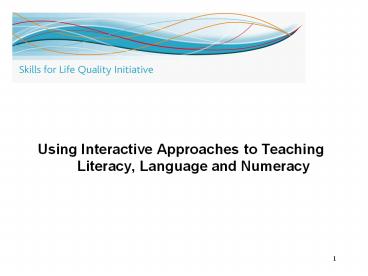Using Interactive Approaches to Teaching Literacy, Language and Numeracy - PowerPoint PPT Presentation
1 / 19
Title:
Using Interactive Approaches to Teaching Literacy, Language and Numeracy
Description:
Using Interactive Approaches to Teaching Literacy, Language and Numeracy Aim To enable you to extend your range of group and interactive teaching techniques to ... – PowerPoint PPT presentation
Number of Views:36
Avg rating:3.0/5.0
Title: Using Interactive Approaches to Teaching Literacy, Language and Numeracy
1
- Using Interactive Approaches to Teaching
Literacy, Language and Numeracy
2
- Aim
- To enable you to extend your range of group and
interactive teaching techniques to support your
learners literacy, language and numeracy skills
development.
3
Outcomes
- By the end of the session you will have
- gained an understanding of some approaches to
differentiation and how to use them effectively - created ideas for interactive group activities
and effective questioning techniques to use in
embedded sessions - continued
4
Outcomes continued
- developed a plan for an interactive activity for
learners in an embedded session - received feedback that will enable you to use
interactive approaches effectively.
5
What is active learning and why does it work?
- We learn by doing. Research shows that active
learning is much better recalled, enjoyed and
understood. Active methods require us to make
our own meaning, that is, develop our own
conceptualisations of what we are learning.
During this process we physically make neural
connections in our brain, the process we call
learning. Passive methods such as listening do
not require us to make these neural connections
or conceptualisations. - (Petty, 2004)
6
Learning retention
Teaching methods and effective learning
7
Characteristics of effective active learning
- Challenging goals
- Active learning towards these goals
- Feedback on the extent to which these goals have
been met - Constructivist teaching methods
8
Constructivism
New learning
Links that create understanding
Existing concepts, knowledge and experience
9
Blooms Taxonomy
- Developmental tasks e.g.
- Give strengths and weaknesses
- Give arguments for and against
- Suggest improvements
- Design a poster
- Evaluation Harder
- Synthesis
- Analysis
- Application
- Comprehension
- Knowledge Easier
- Mastery tasks for example
- Apply
- State
- Define
- Explain
10
Surface and deep learning
Mun falls out of flee. On Saturdays Ted goes
culping. Last Saturday he took God with him. The
mun clizzed and the firz shad. When they arrived,
Ted sulted God. God said, Thank Spult, then
sulted Ted. Eventually they culped until the mun
fell out of the flee.
- Q1. What did Ted do last Saturday?
- Q2. What can you say about the mun and the firz?
- Q3. Do you need to understand the text to answer
low-level questions? - Q4. How effective were the muns actions?
- Q5. Why should culping be encouraged?
11
Surface and deep learning
- 80 of 12 year olds can correctly divide 225 by
15. But only 40 can solve the problem - If a gardener has 225 bulbs to place equally in
15 flower beds, how many bulbs would be in each
bed?
12
Differentiation
- Differentiation is the process of identifying,
with each learner, the most effective strategies
for achieving agreed targets. - (Weston, 1992)
13
Using Blooms Taxonomy to help differentiate and
to achieve deep learning
- a. Everyone can learn more but motivation and
rate of achievement varies. - b. Teachers and instructional style make the
difference. Consider - task, outcome, time allowed
- different learning preferences
- individual targets
- feedback.
14
Getting interactivity into direct instruction
- Direct instruction is a teacher-centred activity.
- The challenge is to intersperse input with
learner interaction and feedback. - Common characteristics of poor practice
- there is no practice for learners
- there is no feedback
- some learners opt out
- some learners have poor concentration.
15
Getting interactivity into direct instruction
- Which questioning strategy works best?
- Consider
- participation rate
- teachers feedback
- learners feedback
- learner comfort
- thinking time.
16
Reciprocal teaching
- is an interactive, group activity using
discussion and explanation - teaches reading comprehension sub-skills
- makes reading strategies explicit
- questioning
- summarising
- clarifying
- predicting.
17
Decisions, decisions
- Matching
- Match question and answer
- problem and solution
- technical word and meaning
- parts and their function.
18
Decisions, decisions
Grouping Group agree, disagree, dont
know sometimes true, always true, never
true Classify items. Put some spurious cards in
too!
love
run
talk
rat
pen
write
sit
tree
flute
blue
19
Decisions, decisions
- Ranking and sequencing
- Rank by time, order or by a continuum, for
example. - Put the cards in time order.
- Rank actions to create a database query.
- Rank by least and most effective, important,
useful, serious, and so on.
1/4
2/3
21/2
Turn off electricity
Check ABC
Ring 999































